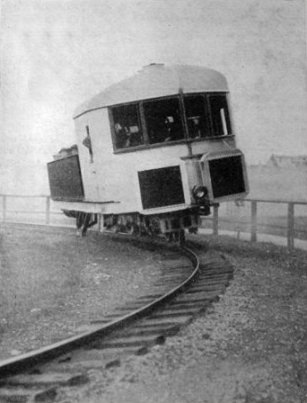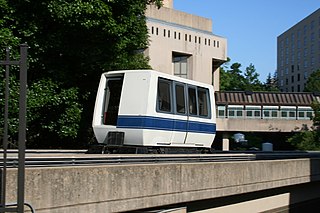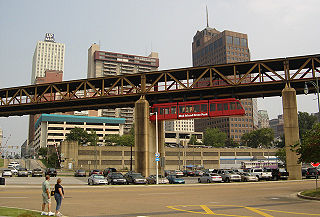
A monorail is a railway in which the track consists of a single rail or beam. Colloquially, the term "monorail" is often used to describe any form of elevated rail or people mover. More accurately, the term refers to the style of track. Monorail systems are most frequently implemented in large cities, airports, and theme parks.

A linear motor is an electric motor that has had its stator and rotor "unrolled", thus, instead of producing a torque (rotation), it produces a linear force along its length. However, linear motors are not necessarily straight. Characteristically, a linear motor's active section has ends, whereas more conventional motors are arranged as a continuous loop.

Transrapid is a German-developed high-speed monorail train using magnetic levitation. Planning for the system started in the late 1960s, with a test facility in Emsland, Germany inaugurated in 1983. In 1991, technical readiness for application was approved by the Deutsche Bundesbahn in cooperation with renowned universities.

Maglev is a system of rail transport whose rolling stock is levitated by electromagnets rather than rolled on wheels, eliminating rolling resistance.

The Saint Petersburg to Moscow railway runs for 649.7 kilometers (403.7 mi) through four oblasts: Leningrad, Novgorod, Tver and Moscow. It is a major traffic artery in the north-west region of Russia, operated by the October Railway subdivision of Russian Railways.

The H-Bahn in Dortmund and Düsseldorf is a driverless passenger suspension railway system. The system was developed by Siemens, who call the project SIPEM.

The gyro monorail, gyroscopic monorail, gyro-stabilized monorail, or gyrocar are terms for a single rail land vehicle that uses the gyroscopic action of a spinning wheel to overcome the inherent instability of balancing on top of a single rail.
The term monorail or industrial monorail is used to describe any number of transport systems in which a chair or carrier is suspended from, or rides on, an overhead rail structure. Unlike the well-known duo-rail system, there are many rail-guided transport options which have been described as monorails, so that tracing the history presents a demarcation problem regarding what should be included and what should be omitted.

The Moscow Monorail is a 4.7-kilometre-long (2.9 mi) monorail line located in the North-Eastern Administrative Okrug of Moscow, Russia. It runs from the Timiryazevskaya via Fonvisinskaya and VDNHa metro stations to Sergeya Eisensteina street. The monorail line currently has six stations. Planning of the monorail in Moscow started in 1998. This was a unique project for Russian companies, which did not have prior experience in building monorails. 6,335,510,000 ₽ were spent by the city of Moscow on the monorail construction.

The Sharopoyezd, also known as ShELT was a Soviet attempt to develop a high-speed rail system in the 1930s. Instead of iron rails, the design specified a single, large concave rail made of concrete.
Ivan Kirillovich Elmanov was a Russian inventor. During 1820, in Myachkovo, near Moscow, he built a type of monorail described as a road on pillars. The single rail was made of timber balks resting above the pillars. The wheels were set on this wooden rail, while the horse-drawn carriage had a sled on its top. This construction is considered to be the first known monorail in the world.

A hovertrain is a type of high-speed train that replaces conventional steel wheels with hovercraft lift pads, and the conventional railway bed with a paved road-like surface, known as the track or guideway. The concept aims to eliminate rolling resistance and allow very high performance, while also simplifying the infrastructure needed to lay new lines. Hovertrain is a generic term, and the vehicles are more commonly referred to by their project names where they were developed. In the UK they are known as tracked hovercraft, in the US they are tracked air-cushion vehicles. The first hovertrain was developed by Jean Bertin in the early 1960s in France, where they were marketed as the Aérotrain before being abandoned by the French government.

High-speed rail is emerging in Russia as an increasingly popular means of transport, where it is twice as fast as the regular express trains between Moscow and Saint Petersburg.

The 81-717/81-714 is a Soviet/Russian metro car model and the most produced member of the 81-series, designed in the Soviet Union in the mid-1970s. The cars were made from 1976 to 2014 by Metrovagonmash and the I. E. Yegorov Vagonmash factories of Mytishchi and Saint Petersburg, respectively. Production is still ongoing for specific modifications, and is both the most produced metro train ever, currently being used in 11 countries worldwide, in 19 metropolitans, and having been produced in 24 different modifications in total, as well as the longest produced metro train ever, with over 7,000 cars having been produced in total so far.

A suspension railway is a form of elevated monorail in which the vehicle is suspended from a fixed track, which is built above streets, waterways, or existing railway track.

The ChS8 is an electric mainline AC passenger locomotive used in Russia and Ukraine.
The Heilmann locomotives were a series of three experimental steam-electric locomotives produced in the 1890s for the French Chemins de fer de l'Ouest. A prototype was built in 1894 and two larger locomotives were built in 1897. These locomotives used electric transmission, much like later-popular diesel-electric locomotives and various other self powered locomotives.

The University of the Philippines Diliman AGT was an automated guideway transit (AGT) system constructed for technology demonstration within the campus of the University of the Philippines (UP) in Diliman, Quezon City in the Philippines. It served as a test track for the first mass transit system to be built and developed in the country by local engineers.

The Lastochka is a German/Russian commuter intercity electric multiple unit train used across multiple Russian cities, based on the Siemens Desiro design and manufactured by Siemens and Ural Locomotives.















